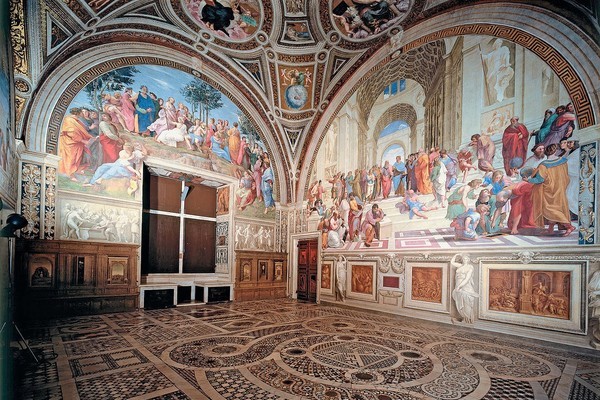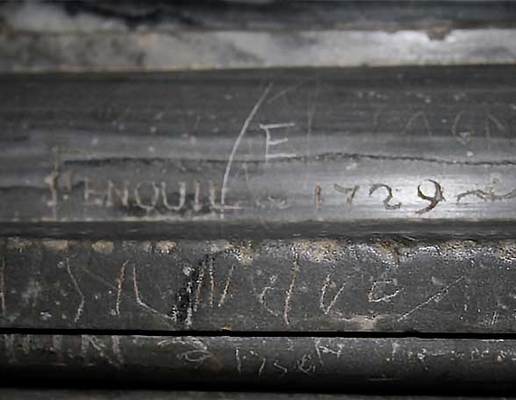Imagine the surprise and astonishment people must have felt upon entering the apartment of Pope Julius II, with its marvelous frescoes by Raphael and his school.
Graffiti dated 1729 in the Heliodoro Room Raphael was the most admired among the artists- especially during the XVII and XVIII centuries. He was even more revered than Michelangelo, because of the elegance of his decorations, the harmony of his compositions of figures, and the perfect architectonic perspectives he could create. These beautiful rooms were also the symbol of the power and richness of life in the Vatican.
We have proof of the impression this room had on the people that walked in, from the inscriptions and engravings left on the walls. If you look attentively at the lower part of the walls you can see graffiti with names, figures, and symbols.
The oldest date back to 1527, shortly after the end of the decoration of the apartment, when the Landsknechte (protestant mercenary soldiers sent by Charles V) occupied and sacked Rome, forcing the Pope to escape from the Vatican and seek protection in Castel Sant’Angelo.
Writing on the walls, over those beautiful images, was a way for the Landsknechte to outrage the residents and violate the sacredness of the place. In the Stanza della Segnatura on the fresco with the Dispute of the Holy Sacrament where the community of God on earth is represented by the Roman Church, graffiti read, “W Luther” and “Celebrate Charles V.”

Admire Raphael's Rooms during our Vatican Early Morning Prime Tour
Historians today can read the history of the rooms through the very important evidence left by those who entered and felt the burning desire to leave proof of their passage. Some did it with outraging intentions (as the Landsknechte) but some left their signature just as a demonstration of how important it had been for them to see the paintings. This might be the reason why a significant Catholic painter, the French Nicolas Poussin (1594-1665), left his name engraved on the fireplace of the Heliodorus room.
On the left side of the marble fireplace an inscription says:
“Nicholas Poussin 1627”
Could he have written it himself?

Nobody can answer this question with absolute certainty. Nevertheless, we know that Nicolas Poussin was the most important French painter of the 17th century and the leading artist of the classical French Baroque style. He moved to Rome in 1624 and he soon started working for Cardinal Francesco Barberini, nephew of the ruling Pope Urban VIII. In 1628 he painted for Saint Peter’s Basilica the martyrdom of Saint Erasmus which is now conserved in the collection of paintings of the museums. He never attended the Academy of art and had learned to paint and draw by copying and studying the major artists of the Italian Renaissance- in particular Leonardo Da Vinci and Raphael.
While in Rome, he was given the opportunity to visit the rooms frescoed by his favorite artist in the Vatican his protector, Cardinal Barberini. We can imagine him, alone in the room, with pencils and paper, studying and reproducing the faces of the figures, their attitudes, how they look at each other, fascinated by the ability of Raphael and the beautifully painted architecture. We can imagine him taking his knife from his pocket and engraving his name somewhere that he would not ruin any painting- just as a way to say he was there, conscious that what he had just seen would have affected his art forever and that one day we would know.
Not far from the name of Nicolas Poussin, on the same fireplace, an art historian would notice another name, that of Filippo Agricola (1795-1857). While the name Nicolas Poussin might sound familiar to many people, Filippo Agricola is more anonymous. Reading the history of Rome and the Vatican though, you would discover that he was very well-known to his contemporaries.
In 1812, at the age of 17, he won a prize entitled to Napoleon by painting “Mario meditating over the ruins of Carthage.” That was the beginning of an important career that led to him becoming first an art teacher and then the director of the Vatican school of Mosaic. Finally, in 1839 as Inspector of Paintings of the Holy Apostolic Palaces, he was involved in cleaning and conserving the rooms decorated by Raphael. Can this be a coincidence?
Choose your favorite Private Vatican Tour and try to find the hidden graffiti!


